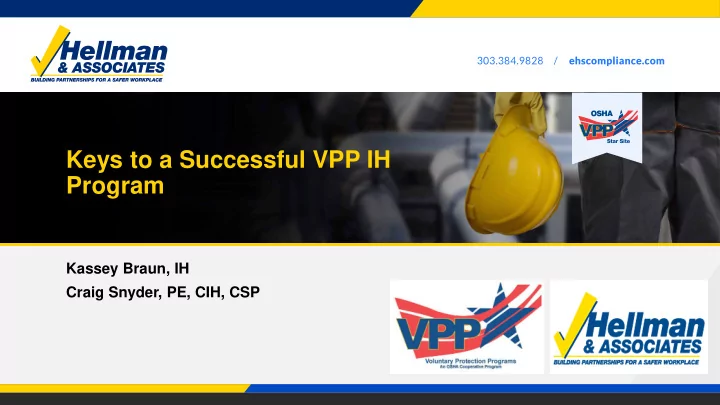

Keys to a Successful VPP IH Program Kassey Braun, IH Craig Snyder, PE, CIH, CSP
Food for Thought • Do you have a formal IH program? • What IH goals do you have for 2019? • How do you account for exposures when starting a new project? • Is your program thriving?
OSHA VPP Site-Based Participation Evaluation Report
OSHA VPP Site-Based Participation Evaluation Report
OSHA VPP Site-Based Participation Evaluation Report
Search for the Key Where to Start Building • Inventory your exposures • Make priorities and build a sampling plan • Consider statistical significance
Evaluate Your Operations • Best practice is for companies to develop Job Hazard Analysis (JHA) • Inventory of exposures should occur when JHAs are developed • Use chemical inventory required per 1910.1200. • Look at SDSs and labels
Hellman & Associates JHAs
Hellman & Associates JHAs
Hellman & Associates Project Checklist
Feed Production Facility
Food & Beverage Industry
Looking Further at Exposures • Do chemicals have occupational exposure limits? • Which chemicals have the lowest exposure limits? • Do chemicals have IH sampling methods? • Which chemicals are used the most frequently and in the largest quantity? • Have you sampled those chemicals in previous years? • How confident are you in the data?
Data Points & TLVs / BEIs
Regulations & Exposures
AIHA Exposure Assessment Strategy Diagram
Chemical Assessment Flow Chart
Monitoring and Statistical Analysis
Search for the Key: Where to Start Building • Inventory your exposures. • Make priorities and build a sampling plan. • Consider statistical significance.
Hellman & Associates – The Basic Plan • Set an annual goal to conduct monitoring on client sites when available. • Review goals at each safety committee and staff meeting. • Wear PPE to match client current requirements (as a minimum). • Complete reports for individual exposure in addition to client’s official IH report.
H&A Safety Goals
Oil & Gas Monitoring
Oil & Gas Monitoring
Oil & Gas Monitoring
Other Occupational Exposure Limits
Oil & Gas Monitoring
Exposure Monitoring Summary Form
Building on the Basics – The Advanced Approach • Look at developing internal OELs • Consider exposure banding • Set goals for number of samples to collect each year • Repeat monitoring for tasks that require controls (engineering, PPE, etc.) • Increase number of samples from the minimum needed • Track and trend results (data analysis) • Develop similar exposure groups (SEGs)
Case Study – Food & Beverage • Goal: Create a corporate program that would allow sites to easily develop written IH programs that could be recognized as best practice by OSHA VPP • Consider AIHA model • Consider statistical significance • Create documentation for consistency across multiple locations
AIHA Exposure Assessment Strategy
AIHA Exposure Decision Categories
Baseline Assessment • Qualitative assessment (some diagnostic monitoring may be performed) • Review of health hazards without regard to use of PPE • Process observation • SDS review • Engineering and work practice review • Can be a series of assessments over time, does not need to happen all at the same time • Assessment tool provided • Outcome is prioritized list of processes/tasks that required a detailed IH assessment and those that are lower in priority • Allows limited resources to be focused
SEGs and Rule of Thumb • The “rule -of-thumb ” is to collect 6 to 10 personal exposure samples per SEG in order to achieve statistical significance. • If the sample results are significantly different (i.e., by an order of magnitude) then the SEG should be reviewed to determine if the employees were properly grouped • This situation may be the result of differing employee work practices which must be addressed rather than improper grouping • If the process or task is changed in any way that would impact employee exposure (e.g., ventilation system chance, product substitution) then a new data set would need to be generated
From Appendix B-2 Qualitative Assessment Form
Air Contaminant Required Action Summary Table
From Appendix C – IH Monitoring Plan
From Appendix D – IH Summary Log
From Appendix I – Medical Surveillance Summary
From Appendix J – Notification of Results
From Appendix K – Annual Program Review
Case Study - Pharmaceutical • Large focus on relieving respiratory protection upon installation of engineering controls. • Corporate toxicologists develop exposure limits for finished products and high hazard raw materials. • Analytical laboratory is given a priority list of methods to develop. • All APIs with limits and methods are sampled for. • Individual sites develop annual sampling plans and present to corporate. • Action limits are set at 50% the OEL. • Engineering containment levels.
Industrial Hygiene Exposure Assessment and Control Program
The Use of Controls to Reduce Employee Exposures
Industrial Hygiene Program Process
Exposure Limits
Dex ESTL & Dex SCHH
Field Assessment
Sample Data & Results
Sample Data & Results
Sample Data & Results
Access to Resources
Winston Churchill “Continuous effort – not strength or intelligence – is the key to unlocking our potential.” - Winston Churchill
You Have the Keys - Now Go Open Greatness • Ask for help if you need it! • Remember to consider all hazards at your job site (chemical, noise, radiation, etc.) • PRIORITIZE – Look at exposure limits, amount used, etc. • Control hazards – Hierarchy of hazard control • Gain statistical significance • Reevaluate – At least ANNUALLY
Thank You! Hellman & Associates (303) 384-9828 Craig Snyder, PE, CIH, CSP Kassey Braun, ASP, IH
Recommend
More recommend